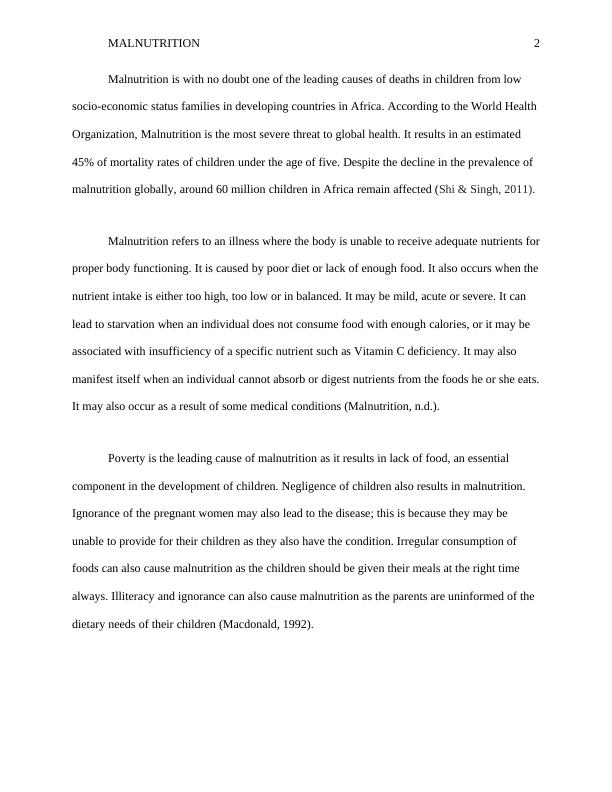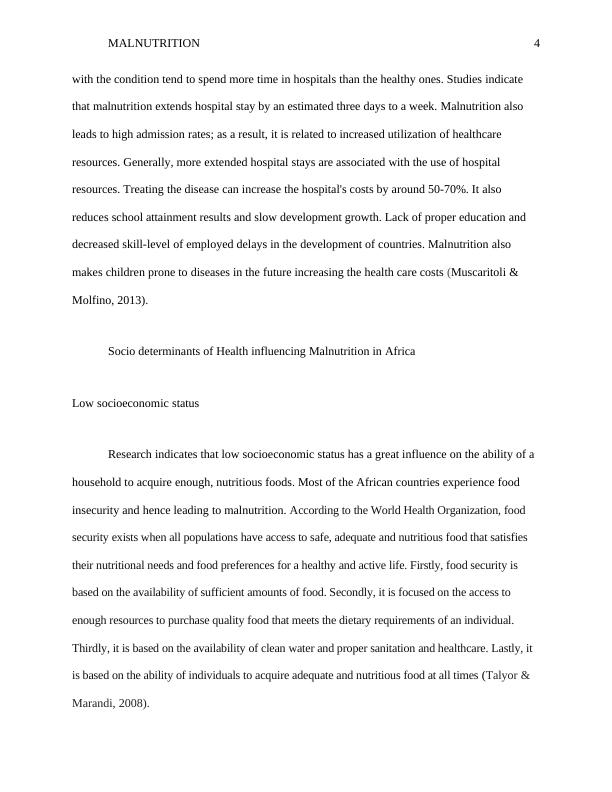(PDF) A descriptive study on Malnutrition
Added on 2021-06-16
16 Pages4072 Words20 Views
Running head: MALNUTRITION 1
Malnutrition
Students Name
Institutional Affiliation
Malnutrition
Students Name
Institutional Affiliation

MALNUTRITION 2
Malnutrition is with no doubt one of the leading causes of deaths in children from low
socio-economic status families in developing countries in Africa. According to the World Health
Organization, Malnutrition is the most severe threat to global health. It results in an estimated
45% of mortality rates of children under the age of five. Despite the decline in the prevalence of
malnutrition globally, around 60 million children in Africa remain affected (Shi & Singh, 2011).
Malnutrition refers to an illness where the body is unable to receive adequate nutrients for
proper body functioning. It is caused by poor diet or lack of enough food. It also occurs when the
nutrient intake is either too high, too low or in balanced. It may be mild, acute or severe. It can
lead to starvation when an individual does not consume food with enough calories, or it may be
associated with insufficiency of a specific nutrient such as Vitamin C deficiency. It may also
manifest itself when an individual cannot absorb or digest nutrients from the foods he or she eats.
It may also occur as a result of some medical conditions (Malnutrition, n.d.).
Poverty is the leading cause of malnutrition as it results in lack of food, an essential
component in the development of children. Negligence of children also results in malnutrition.
Ignorance of the pregnant women may also lead to the disease; this is because they may be
unable to provide for their children as they also have the condition. Irregular consumption of
foods can also cause malnutrition as the children should be given their meals at the right time
always. Illiteracy and ignorance can also cause malnutrition as the parents are uninformed of the
dietary needs of their children (Macdonald, 1992).
Malnutrition is with no doubt one of the leading causes of deaths in children from low
socio-economic status families in developing countries in Africa. According to the World Health
Organization, Malnutrition is the most severe threat to global health. It results in an estimated
45% of mortality rates of children under the age of five. Despite the decline in the prevalence of
malnutrition globally, around 60 million children in Africa remain affected (Shi & Singh, 2011).
Malnutrition refers to an illness where the body is unable to receive adequate nutrients for
proper body functioning. It is caused by poor diet or lack of enough food. It also occurs when the
nutrient intake is either too high, too low or in balanced. It may be mild, acute or severe. It can
lead to starvation when an individual does not consume food with enough calories, or it may be
associated with insufficiency of a specific nutrient such as Vitamin C deficiency. It may also
manifest itself when an individual cannot absorb or digest nutrients from the foods he or she eats.
It may also occur as a result of some medical conditions (Malnutrition, n.d.).
Poverty is the leading cause of malnutrition as it results in lack of food, an essential
component in the development of children. Negligence of children also results in malnutrition.
Ignorance of the pregnant women may also lead to the disease; this is because they may be
unable to provide for their children as they also have the condition. Irregular consumption of
foods can also cause malnutrition as the children should be given their meals at the right time
always. Illiteracy and ignorance can also cause malnutrition as the parents are uninformed of the
dietary needs of their children (Macdonald, 1992).

MALNUTRITION 3
Malnutrition has numerous effects both on the body of children and the economy of the
countries. It leads to the death of children under the age of five, negatively impacting on the
economy due to lack of enough workforce. It also makes children vulnerable to diseases as a
result of a weak immune system. Studies indicate that malnourished children often suffer from
conditions such as pneumonia, diarrhea, HIV, Malaria, and Measles. The relationship between
Malnutrition and disease manifestation is a circularity as it causes increased susceptibility to
infections while the infections also lead to malnutrition. The infections result into loss of
appetite, malabsorption of nutrients, urinary nitrogen loss, and redirection of nutrients for
immune response and excessive damage of the immune system. This then leads to inadequate
dietary intake and hence loss of nutrients (Oberhuber, 2013).
Malnutrition results in kwashiorkor which is a type of protein insufficiency that is usual
among the malnourished children. If left untreated it leads to loss of lives or coma. It also leads
to marasmus, which is characterized by the deficiency of all the nutrients especially proteins and
calories. Marasmus is also characterized by severe loss of weight and hair loss. It also leads to
the inadequate amount of nutrients such as carbohydrates, proteins, vitamins, and minerals.
Malnutrition also results in weight loss and impaired growth and development of the children
hence making it difficult to attain their optimal size and physical potential as adults. The
undernourished children often have lower intellectual capacities than that of the well fed
children. This is due to the illnesses that manifest in the bodies hugely affecting their mental
abilities. It also leads to the children’s slow recuperation to diseases.
Malnutrition presents a severe health burden on countries hindering development efforts.
Countries spend more on treating malnourished children than on preventing the disease. Patients
Malnutrition has numerous effects both on the body of children and the economy of the
countries. It leads to the death of children under the age of five, negatively impacting on the
economy due to lack of enough workforce. It also makes children vulnerable to diseases as a
result of a weak immune system. Studies indicate that malnourished children often suffer from
conditions such as pneumonia, diarrhea, HIV, Malaria, and Measles. The relationship between
Malnutrition and disease manifestation is a circularity as it causes increased susceptibility to
infections while the infections also lead to malnutrition. The infections result into loss of
appetite, malabsorption of nutrients, urinary nitrogen loss, and redirection of nutrients for
immune response and excessive damage of the immune system. This then leads to inadequate
dietary intake and hence loss of nutrients (Oberhuber, 2013).
Malnutrition results in kwashiorkor which is a type of protein insufficiency that is usual
among the malnourished children. If left untreated it leads to loss of lives or coma. It also leads
to marasmus, which is characterized by the deficiency of all the nutrients especially proteins and
calories. Marasmus is also characterized by severe loss of weight and hair loss. It also leads to
the inadequate amount of nutrients such as carbohydrates, proteins, vitamins, and minerals.
Malnutrition also results in weight loss and impaired growth and development of the children
hence making it difficult to attain their optimal size and physical potential as adults. The
undernourished children often have lower intellectual capacities than that of the well fed
children. This is due to the illnesses that manifest in the bodies hugely affecting their mental
abilities. It also leads to the children’s slow recuperation to diseases.
Malnutrition presents a severe health burden on countries hindering development efforts.
Countries spend more on treating malnourished children than on preventing the disease. Patients

MALNUTRITION 4
with the condition tend to spend more time in hospitals than the healthy ones. Studies indicate
that malnutrition extends hospital stay by an estimated three days to a week. Malnutrition also
leads to high admission rates; as a result, it is related to increased utilization of healthcare
resources. Generally, more extended hospital stays are associated with the use of hospital
resources. Treating the disease can increase the hospital's costs by around 50-70%. It also
reduces school attainment results and slow development growth. Lack of proper education and
decreased skill-level of employed delays in the development of countries. Malnutrition also
makes children prone to diseases in the future increasing the health care costs (Muscaritoli &
Molfino, 2013).
Socio determinants of Health influencing Malnutrition in Africa
Low socioeconomic status
Research indicates that low socioeconomic status has a great influence on the ability of a
household to acquire enough, nutritious foods. Most of the African countries experience food
insecurity and hence leading to malnutrition. According to the World Health Organization, food
security exists when all populations have access to safe, adequate and nutritious food that satisfies
their nutritional needs and food preferences for a healthy and active life. Firstly, food security is
based on the availability of sufficient amounts of food. Secondly, it is focused on the access to
enough resources to purchase quality food that meets the dietary requirements of an individual.
Thirdly, it is based on the availability of clean water and proper sanitation and healthcare. Lastly, it
is based on the ability of individuals to acquire adequate and nutritious food at all times (Talyor &
Marandi, 2008).
with the condition tend to spend more time in hospitals than the healthy ones. Studies indicate
that malnutrition extends hospital stay by an estimated three days to a week. Malnutrition also
leads to high admission rates; as a result, it is related to increased utilization of healthcare
resources. Generally, more extended hospital stays are associated with the use of hospital
resources. Treating the disease can increase the hospital's costs by around 50-70%. It also
reduces school attainment results and slow development growth. Lack of proper education and
decreased skill-level of employed delays in the development of countries. Malnutrition also
makes children prone to diseases in the future increasing the health care costs (Muscaritoli &
Molfino, 2013).
Socio determinants of Health influencing Malnutrition in Africa
Low socioeconomic status
Research indicates that low socioeconomic status has a great influence on the ability of a
household to acquire enough, nutritious foods. Most of the African countries experience food
insecurity and hence leading to malnutrition. According to the World Health Organization, food
security exists when all populations have access to safe, adequate and nutritious food that satisfies
their nutritional needs and food preferences for a healthy and active life. Firstly, food security is
based on the availability of sufficient amounts of food. Secondly, it is focused on the access to
enough resources to purchase quality food that meets the dietary requirements of an individual.
Thirdly, it is based on the availability of clean water and proper sanitation and healthcare. Lastly, it
is based on the ability of individuals to acquire adequate and nutritious food at all times (Talyor &
Marandi, 2008).

End of preview
Want to access all the pages? Upload your documents or become a member.
Related Documents
Malnutrition: Causes, Effects, and Solutionslg...
|8
|2913
|23
Nutritional Evaluation of Soy Productslg...
|7
|1394
|86
Impacts of Maternal and Child Under-nutritionlg...
|13
|3495
|372
Functional Foods for Elderly People in Residential Care Unitslg...
|12
|3120
|209
International Nutrition Issues: Understanding the Impact of Vitamin Deficiencies and Significance of Healthy Dietslg...
|17
|3210
|182
Dietary and nutrient intake of 25 elderly males above the age of 71 yearslg...
|11
|2590
|401
